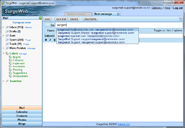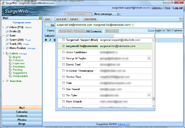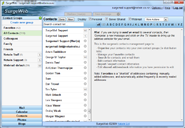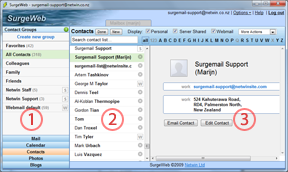SurgeWeb Contacts
There are three aspects to the surgeweb contacts interface: As you use surgeweb the addresses of the people you email will automatically get added to the contacts list and you will probably find you will just use the autocompletion. The picker can be used to add recipients or groups to an email when composing a message and the management page is used to edit and organise your contact information.Autocompletion and recipients field
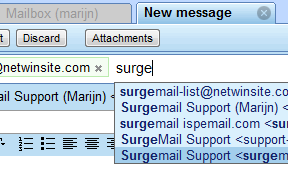
Not much to say here, it's autocompletion... you start typing a few characters, surgeweb autocompletes and you pick the address by mouse or by keyboard.
Already added recipients can be removed by pressing the small cross.
Contact picker

The picker allows you at quickly select and add multiple recipients to your email. Press the To button, optionally filter by search criteria, and select the addresses you want to add.
Three different sets of contacts are currently selectable:
- Favorites - this is the list of 20 most emailed contacts ever, plus the the 20 most recently emailed contacts, plus any you have manually added.
- Groups - Groups can be added to the the recipient list. It is possible to see who is in each group before adding the group.
- All contacts - All the contacts - dependant on the contacts source on the management page this will be the email addresses in your personal contacts, plus all shared addressbooks, plus any webmail addressbooks you may still have.
The contacts management page
The contacts management page allows you to do various more detailed contacts management functions. This includes organising contacts into groups (aka distribution lists), manually add or remove contact information, edit contacts providing additional information.
The page contains 3 main panes:
- Left hand pane listing various forms of groups of contacts
- Center pane of all the contacts in the group selected in the left
- Right hand pane of detailed contact information for a particular contacts.
Source of contact information
Surgeweb conceptually works with a single list of contacts that gets sourced from one of several locations. Primarily your surgeweb personal contacts (see 5 below). However in addition there may be access to shared contacts, and any webmail contacts. These sources can be individually enabled using the appropriate tickboxes.

The source of individual contacts is displayed (see 6 above) as part of the list as per icon. Webmail contacts are always readonly in surgeweb. Shared contacts are readonly unless abook rules have been defined that specifically give you permission to edit the shared addressbook.
| personal surgeweb contact (editable) | Server shared contact | webmail contact |
Groups
A group is a grouping of contacts for easy management. A group can be used as a recipient so can be treated as a distribution list. To organise contacts into just drag and drop a surgeweb contact (ie with a round circle) into the the group of choice.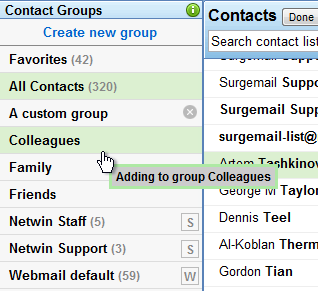
- The same contact information can be part of multiple groups
- The "Favorites" special group automatically contains most frequently and recently mailed addresses. Other addresses can be manually added.
- The "All Contacts" is a list of all the contacts surgeweb knows about.
- The default groups "Colleagues", "Family" and "Friends" cannot be deleted.
- Any Webmail addressbooks (loaded as read only) are listed as a group
- Groups may also be defined in shared addressbooks
Searching / filtering the contacts
The center pane will list all the contacts in the currently selected group. These can be filtered using the Search field or the index tabs.

Editing contact information
A good selection (see 7) of additional fields is available for adding detailed contact information. For most fields multiple fields can be defined and the "type" of each field is selectable (see 8) eg home, work, etc.
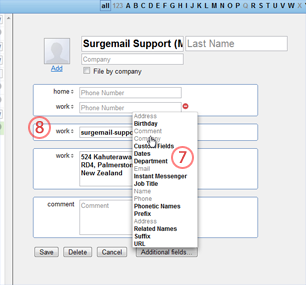
Importing webmail contacts
Webmail contacts are normally displayed as readonly entries in the surgeweb contacts. When a webmail contact is displayed in the details pane, links should be displayed (see 9) that allow just this contact or all webmail contacts to be imported into surgeweb. If all webmail contacts are imported the display of webmail contacts is disabled to avoid entries which are effectively duplication of the same information.
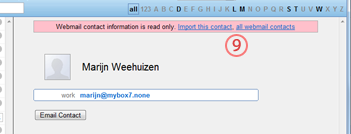
Importing CSV contacts
Outlook formatted contacts CSV files can be imported using the Import option in the "more Actions" menu.
Unimplemented features in the menu
Some features in the "more Actions" menu remain unimplemented for now. These will be implemented as soon as we can manage :-)
Shared contacts (administrator information)
In addition to users own personal contacts, multiple shared addressbooks are available. These can be edited using the surgeweb contacts interface providing permission has been enabled to do so.
Permissions to view and edit shared addressbooks is defined using the abook domain settings in surgemail.ini. These abook entries can also be used to define additional shared addressbooks. By default surgeweb will try and serve a global and domain addressbook as part of a users contacts without the need for abook settings. These are the same format as the user's user.abk file and stored in:
surgemail/abook/Global.abk surgemail/abook/mydomain.com/Domain.abk
You do however, need to add abook settings for the Global and Domain addressbooks in order to edit these using the surgeweb interface.
Here are some possible example abook settings:
abook name="Global" read="*" write="surgeweb_admin"
abook name="Domain" read="*" write="surgeweb_admin"
abook name="Special" read="specials" write="special_admin"
abook name="WideOpen" read="*" write="*"
The above settings allow:
- All accounts to see the global and domain addressbooks. And accounts with "surgeweb_admin" access groups to edit the global and domain addressbooks.
- In addition, a custom addressbook is defined named Special. Any accounts with "specials" groups would get these contacts displayed, This is only editable if an account has the "special_admin" permissions.
- Lastly a custom addressbook is defined named "WideOpen" which any user can edit and will get displayed in every users contacts. (dangerous!)
Note: The above read and write group names are arbitrary and must be defined using g_access_groups.
Users' surgeweb personal contacts are stored in the user.abk file stored in the users' mailstore mdir folder. These are stored in a similar but extended version of the nwauth database files. In fact you could use an nwauth.txt or nwauth.add file directly as a starting point for a surgeweb addressbook - this is particularly useful for getting a shared addressbook started.
Alternatively use the "New contact in..." and "Copy contact..." under more actions menu to get started editing shared addressbooks.
Further additions of being able to talk to an LDAP addressbook, and possibly the current authentication database are planned in the near(ish) future.


